Employee Benefits: LTD Proposal Analysis and Critique Report
VerifiedAdded on 2022/10/18
|8
|1548
|15
Report
AI Summary
This report analyzes a Long-Term Disability (LTD) insurance proposal from Macewan Manufacturing Limited, assessing its key features as presented by the Human Resources Manager. The proposal outlines eligibility criteria for disabled employees, benefit amounts (55% of basic earnings), payment terms, and exclusions related to drug/alcohol abuse, armed forces actions, and mental health conditions. The report critiques the proposal, highlighting strengths such as the clear definition of disability and the provision of financial support, while also raising concerns about the taxation of benefits, the duration of payments until age 65, and the potential financial burden on the employer. The report suggests improvements, including reconsidering the taxation of benefits and reducing the payment timeframe, to enhance the plan's effectiveness and fairness for both employees and the company. The report concludes by emphasizing the importance of LTD benefits and suggesting a few improvements.
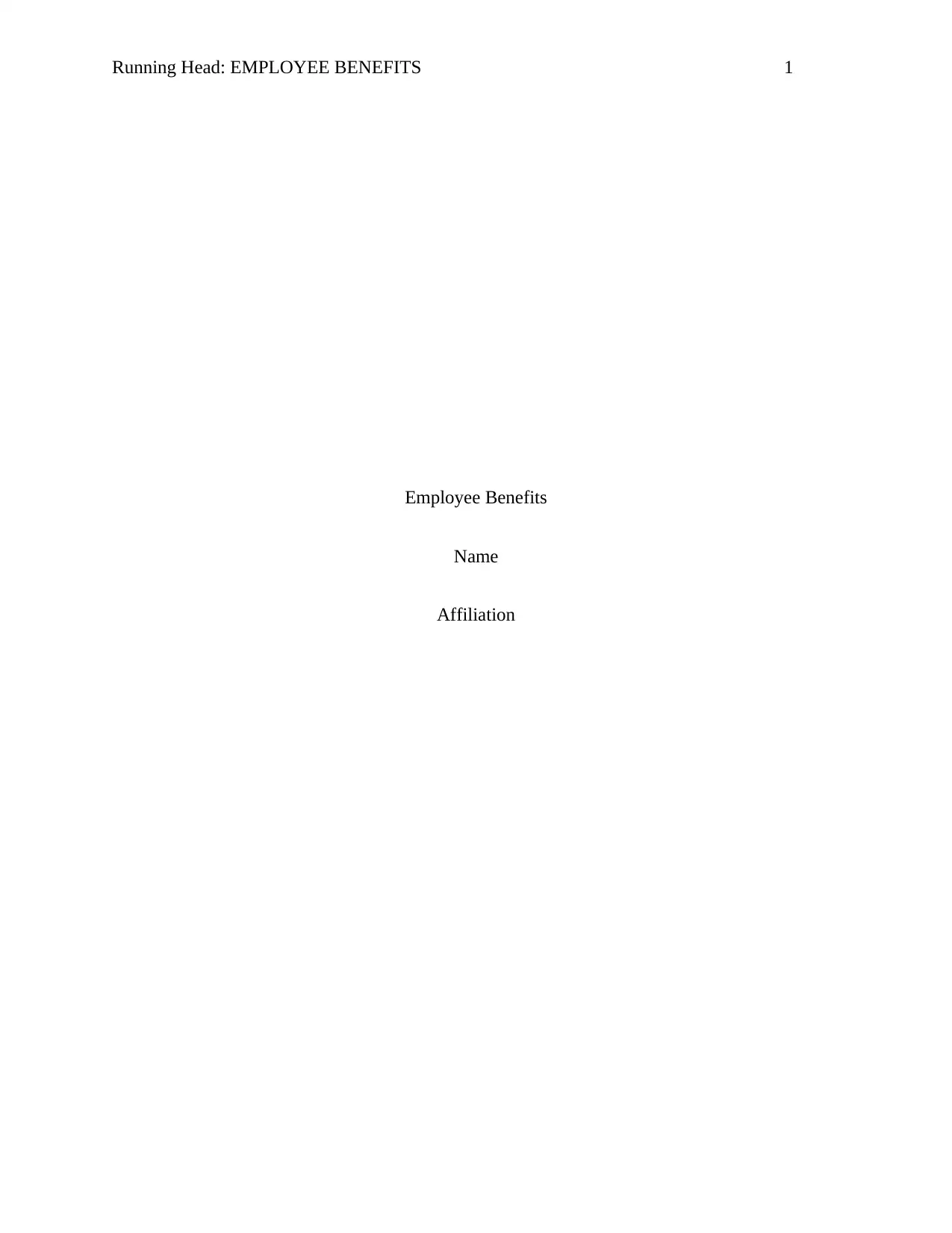
Running Head: EMPLOYEE BENEFITS 1
Employee Benefits
Name
Affiliation
Employee Benefits
Name
Affiliation
Paraphrase This Document
Need a fresh take? Get an instant paraphrase of this document with our AI Paraphraser
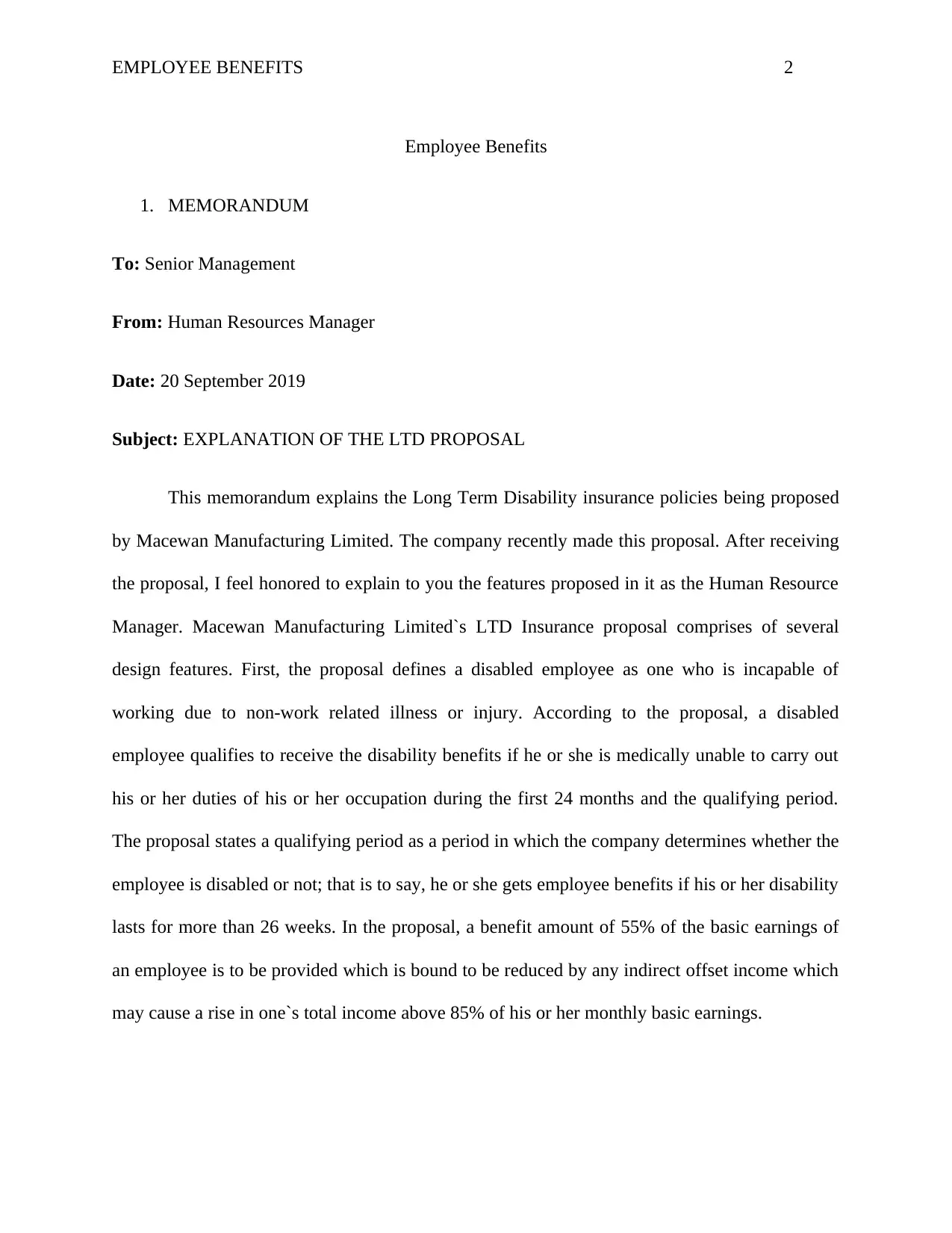
EMPLOYEE BENEFITS 2
Employee Benefits
1. MEMORANDUM
To: Senior Management
From: Human Resources Manager
Date: 20 September 2019
Subject: EXPLANATION OF THE LTD PROPOSAL
This memorandum explains the Long Term Disability insurance policies being proposed
by Macewan Manufacturing Limited. The company recently made this proposal. After receiving
the proposal, I feel honored to explain to you the features proposed in it as the Human Resource
Manager. Macewan Manufacturing Limited`s LTD Insurance proposal comprises of several
design features. First, the proposal defines a disabled employee as one who is incapable of
working due to non-work related illness or injury. According to the proposal, a disabled
employee qualifies to receive the disability benefits if he or she is medically unable to carry out
his or her duties of his or her occupation during the first 24 months and the qualifying period.
The proposal states a qualifying period as a period in which the company determines whether the
employee is disabled or not; that is to say, he or she gets employee benefits if his or her disability
lasts for more than 26 weeks. In the proposal, a benefit amount of 55% of the basic earnings of
an employee is to be provided which is bound to be reduced by any indirect offset income which
may cause a rise in one`s total income above 85% of his or her monthly basic earnings.
Employee Benefits
1. MEMORANDUM
To: Senior Management
From: Human Resources Manager
Date: 20 September 2019
Subject: EXPLANATION OF THE LTD PROPOSAL
This memorandum explains the Long Term Disability insurance policies being proposed
by Macewan Manufacturing Limited. The company recently made this proposal. After receiving
the proposal, I feel honored to explain to you the features proposed in it as the Human Resource
Manager. Macewan Manufacturing Limited`s LTD Insurance proposal comprises of several
design features. First, the proposal defines a disabled employee as one who is incapable of
working due to non-work related illness or injury. According to the proposal, a disabled
employee qualifies to receive the disability benefits if he or she is medically unable to carry out
his or her duties of his or her occupation during the first 24 months and the qualifying period.
The proposal states a qualifying period as a period in which the company determines whether the
employee is disabled or not; that is to say, he or she gets employee benefits if his or her disability
lasts for more than 26 weeks. In the proposal, a benefit amount of 55% of the basic earnings of
an employee is to be provided which is bound to be reduced by any indirect offset income which
may cause a rise in one`s total income above 85% of his or her monthly basic earnings.
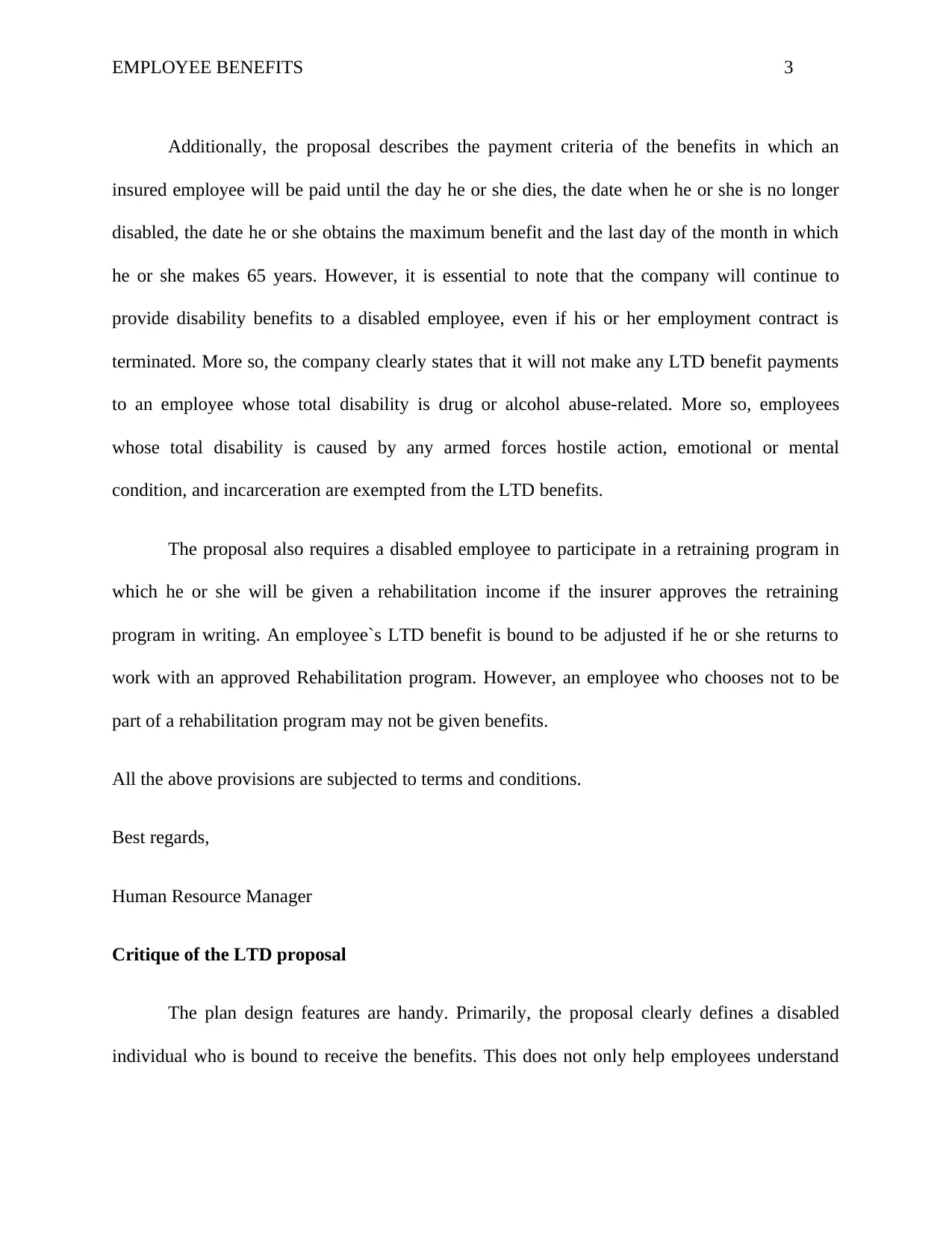
EMPLOYEE BENEFITS 3
Additionally, the proposal describes the payment criteria of the benefits in which an
insured employee will be paid until the day he or she dies, the date when he or she is no longer
disabled, the date he or she obtains the maximum benefit and the last day of the month in which
he or she makes 65 years. However, it is essential to note that the company will continue to
provide disability benefits to a disabled employee, even if his or her employment contract is
terminated. More so, the company clearly states that it will not make any LTD benefit payments
to an employee whose total disability is drug or alcohol abuse-related. More so, employees
whose total disability is caused by any armed forces hostile action, emotional or mental
condition, and incarceration are exempted from the LTD benefits.
The proposal also requires a disabled employee to participate in a retraining program in
which he or she will be given a rehabilitation income if the insurer approves the retraining
program in writing. An employee`s LTD benefit is bound to be adjusted if he or she returns to
work with an approved Rehabilitation program. However, an employee who chooses not to be
part of a rehabilitation program may not be given benefits.
All the above provisions are subjected to terms and conditions.
Best regards,
Human Resource Manager
Critique of the LTD proposal
The plan design features are handy. Primarily, the proposal clearly defines a disabled
individual who is bound to receive the benefits. This does not only help employees understand
Additionally, the proposal describes the payment criteria of the benefits in which an
insured employee will be paid until the day he or she dies, the date when he or she is no longer
disabled, the date he or she obtains the maximum benefit and the last day of the month in which
he or she makes 65 years. However, it is essential to note that the company will continue to
provide disability benefits to a disabled employee, even if his or her employment contract is
terminated. More so, the company clearly states that it will not make any LTD benefit payments
to an employee whose total disability is drug or alcohol abuse-related. More so, employees
whose total disability is caused by any armed forces hostile action, emotional or mental
condition, and incarceration are exempted from the LTD benefits.
The proposal also requires a disabled employee to participate in a retraining program in
which he or she will be given a rehabilitation income if the insurer approves the retraining
program in writing. An employee`s LTD benefit is bound to be adjusted if he or she returns to
work with an approved Rehabilitation program. However, an employee who chooses not to be
part of a rehabilitation program may not be given benefits.
All the above provisions are subjected to terms and conditions.
Best regards,
Human Resource Manager
Critique of the LTD proposal
The plan design features are handy. Primarily, the proposal clearly defines a disabled
individual who is bound to receive the benefits. This does not only help employees understand
⊘ This is a preview!⊘
Do you want full access?
Subscribe today to unlock all pages.

Trusted by 1+ million students worldwide
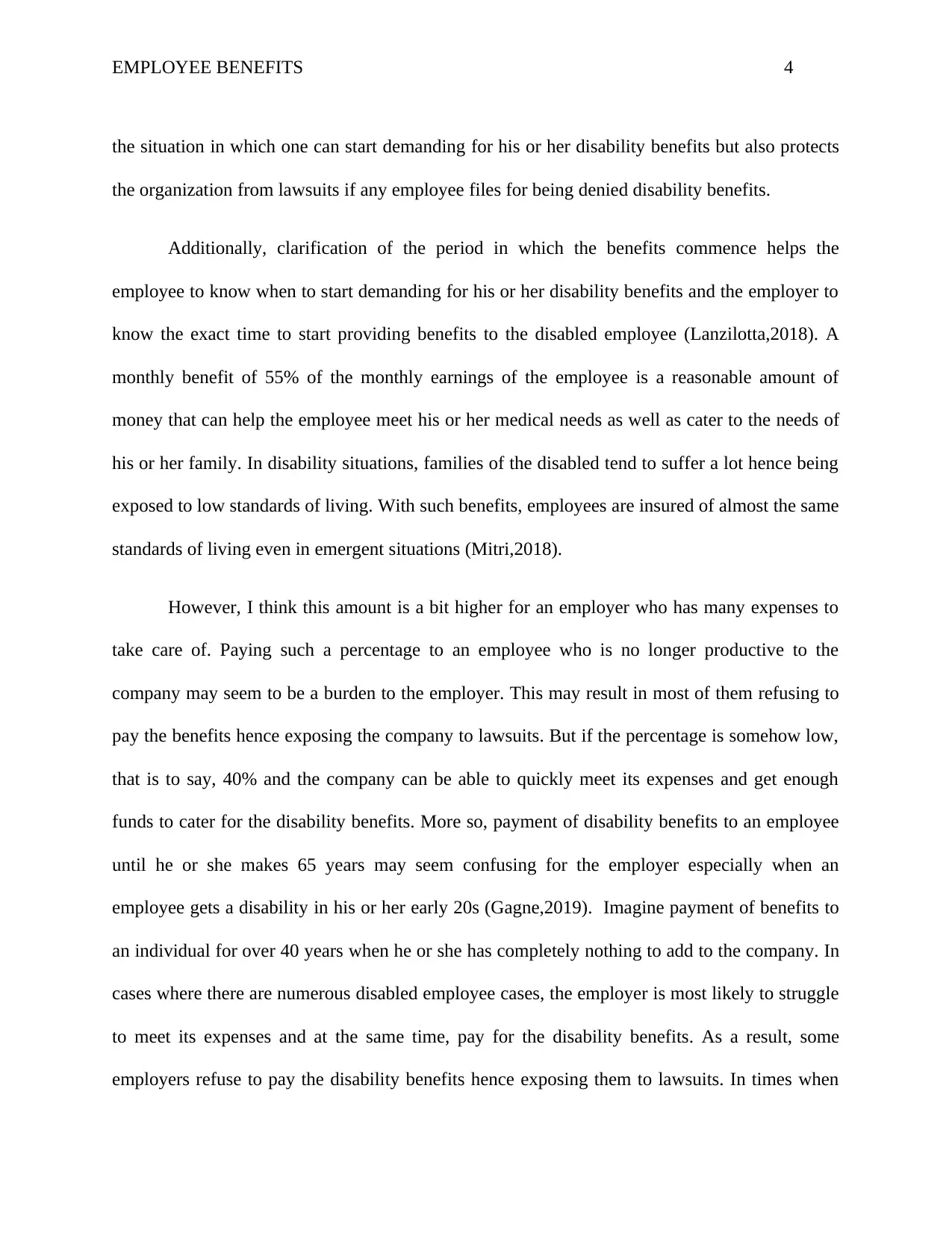
EMPLOYEE BENEFITS 4
the situation in which one can start demanding for his or her disability benefits but also protects
the organization from lawsuits if any employee files for being denied disability benefits.
Additionally, clarification of the period in which the benefits commence helps the
employee to know when to start demanding for his or her disability benefits and the employer to
know the exact time to start providing benefits to the disabled employee (Lanzilotta,2018). A
monthly benefit of 55% of the monthly earnings of the employee is a reasonable amount of
money that can help the employee meet his or her medical needs as well as cater to the needs of
his or her family. In disability situations, families of the disabled tend to suffer a lot hence being
exposed to low standards of living. With such benefits, employees are insured of almost the same
standards of living even in emergent situations (Mitri,2018).
However, I think this amount is a bit higher for an employer who has many expenses to
take care of. Paying such a percentage to an employee who is no longer productive to the
company may seem to be a burden to the employer. This may result in most of them refusing to
pay the benefits hence exposing the company to lawsuits. But if the percentage is somehow low,
that is to say, 40% and the company can be able to quickly meet its expenses and get enough
funds to cater for the disability benefits. More so, payment of disability benefits to an employee
until he or she makes 65 years may seem confusing for the employer especially when an
employee gets a disability in his or her early 20s (Gagne,2019). Imagine payment of benefits to
an individual for over 40 years when he or she has completely nothing to add to the company. In
cases where there are numerous disabled employee cases, the employer is most likely to struggle
to meet its expenses and at the same time, pay for the disability benefits. As a result, some
employers refuse to pay the disability benefits hence exposing them to lawsuits. In times when
the situation in which one can start demanding for his or her disability benefits but also protects
the organization from lawsuits if any employee files for being denied disability benefits.
Additionally, clarification of the period in which the benefits commence helps the
employee to know when to start demanding for his or her disability benefits and the employer to
know the exact time to start providing benefits to the disabled employee (Lanzilotta,2018). A
monthly benefit of 55% of the monthly earnings of the employee is a reasonable amount of
money that can help the employee meet his or her medical needs as well as cater to the needs of
his or her family. In disability situations, families of the disabled tend to suffer a lot hence being
exposed to low standards of living. With such benefits, employees are insured of almost the same
standards of living even in emergent situations (Mitri,2018).
However, I think this amount is a bit higher for an employer who has many expenses to
take care of. Paying such a percentage to an employee who is no longer productive to the
company may seem to be a burden to the employer. This may result in most of them refusing to
pay the benefits hence exposing the company to lawsuits. But if the percentage is somehow low,
that is to say, 40% and the company can be able to quickly meet its expenses and get enough
funds to cater for the disability benefits. More so, payment of disability benefits to an employee
until he or she makes 65 years may seem confusing for the employer especially when an
employee gets a disability in his or her early 20s (Gagne,2019). Imagine payment of benefits to
an individual for over 40 years when he or she has completely nothing to add to the company. In
cases where there are numerous disabled employee cases, the employer is most likely to struggle
to meet its expenses and at the same time, pay for the disability benefits. As a result, some
employers refuse to pay the disability benefits hence exposing them to lawsuits. In times when
Paraphrase This Document
Need a fresh take? Get an instant paraphrase of this document with our AI Paraphraser
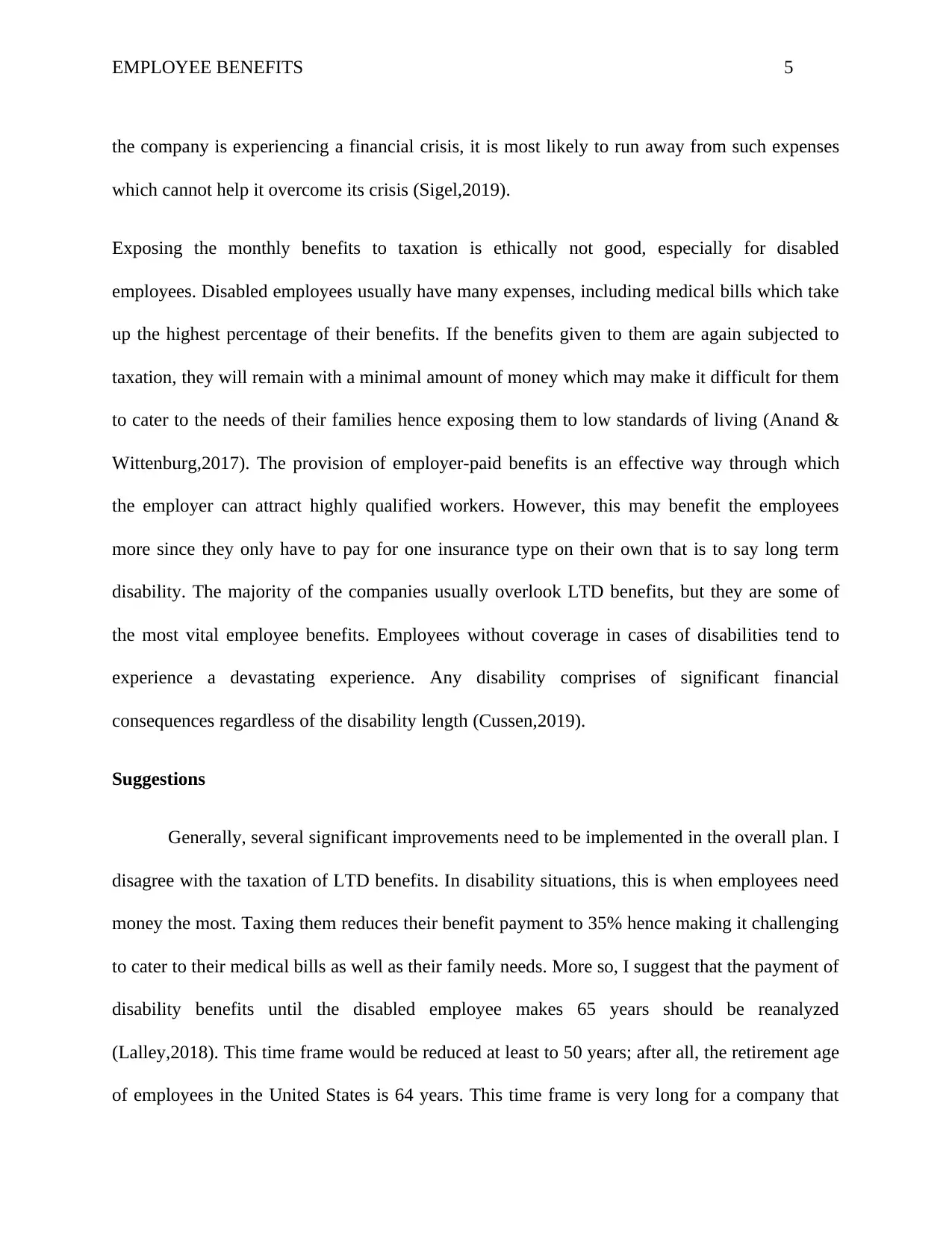
EMPLOYEE BENEFITS 5
the company is experiencing a financial crisis, it is most likely to run away from such expenses
which cannot help it overcome its crisis (Sigel,2019).
Exposing the monthly benefits to taxation is ethically not good, especially for disabled
employees. Disabled employees usually have many expenses, including medical bills which take
up the highest percentage of their benefits. If the benefits given to them are again subjected to
taxation, they will remain with a minimal amount of money which may make it difficult for them
to cater to the needs of their families hence exposing them to low standards of living (Anand &
Wittenburg,2017). The provision of employer-paid benefits is an effective way through which
the employer can attract highly qualified workers. However, this may benefit the employees
more since they only have to pay for one insurance type on their own that is to say long term
disability. The majority of the companies usually overlook LTD benefits, but they are some of
the most vital employee benefits. Employees without coverage in cases of disabilities tend to
experience a devastating experience. Any disability comprises of significant financial
consequences regardless of the disability length (Cussen,2019).
Suggestions
Generally, several significant improvements need to be implemented in the overall plan. I
disagree with the taxation of LTD benefits. In disability situations, this is when employees need
money the most. Taxing them reduces their benefit payment to 35% hence making it challenging
to cater to their medical bills as well as their family needs. More so, I suggest that the payment of
disability benefits until the disabled employee makes 65 years should be reanalyzed
(Lalley,2018). This time frame would be reduced at least to 50 years; after all, the retirement age
of employees in the United States is 64 years. This time frame is very long for a company that
the company is experiencing a financial crisis, it is most likely to run away from such expenses
which cannot help it overcome its crisis (Sigel,2019).
Exposing the monthly benefits to taxation is ethically not good, especially for disabled
employees. Disabled employees usually have many expenses, including medical bills which take
up the highest percentage of their benefits. If the benefits given to them are again subjected to
taxation, they will remain with a minimal amount of money which may make it difficult for them
to cater to the needs of their families hence exposing them to low standards of living (Anand &
Wittenburg,2017). The provision of employer-paid benefits is an effective way through which
the employer can attract highly qualified workers. However, this may benefit the employees
more since they only have to pay for one insurance type on their own that is to say long term
disability. The majority of the companies usually overlook LTD benefits, but they are some of
the most vital employee benefits. Employees without coverage in cases of disabilities tend to
experience a devastating experience. Any disability comprises of significant financial
consequences regardless of the disability length (Cussen,2019).
Suggestions
Generally, several significant improvements need to be implemented in the overall plan. I
disagree with the taxation of LTD benefits. In disability situations, this is when employees need
money the most. Taxing them reduces their benefit payment to 35% hence making it challenging
to cater to their medical bills as well as their family needs. More so, I suggest that the payment of
disability benefits until the disabled employee makes 65 years should be reanalyzed
(Lalley,2018). This time frame would be reduced at least to 50 years; after all, the retirement age
of employees in the United States is 64 years. This time frame is very long for a company that
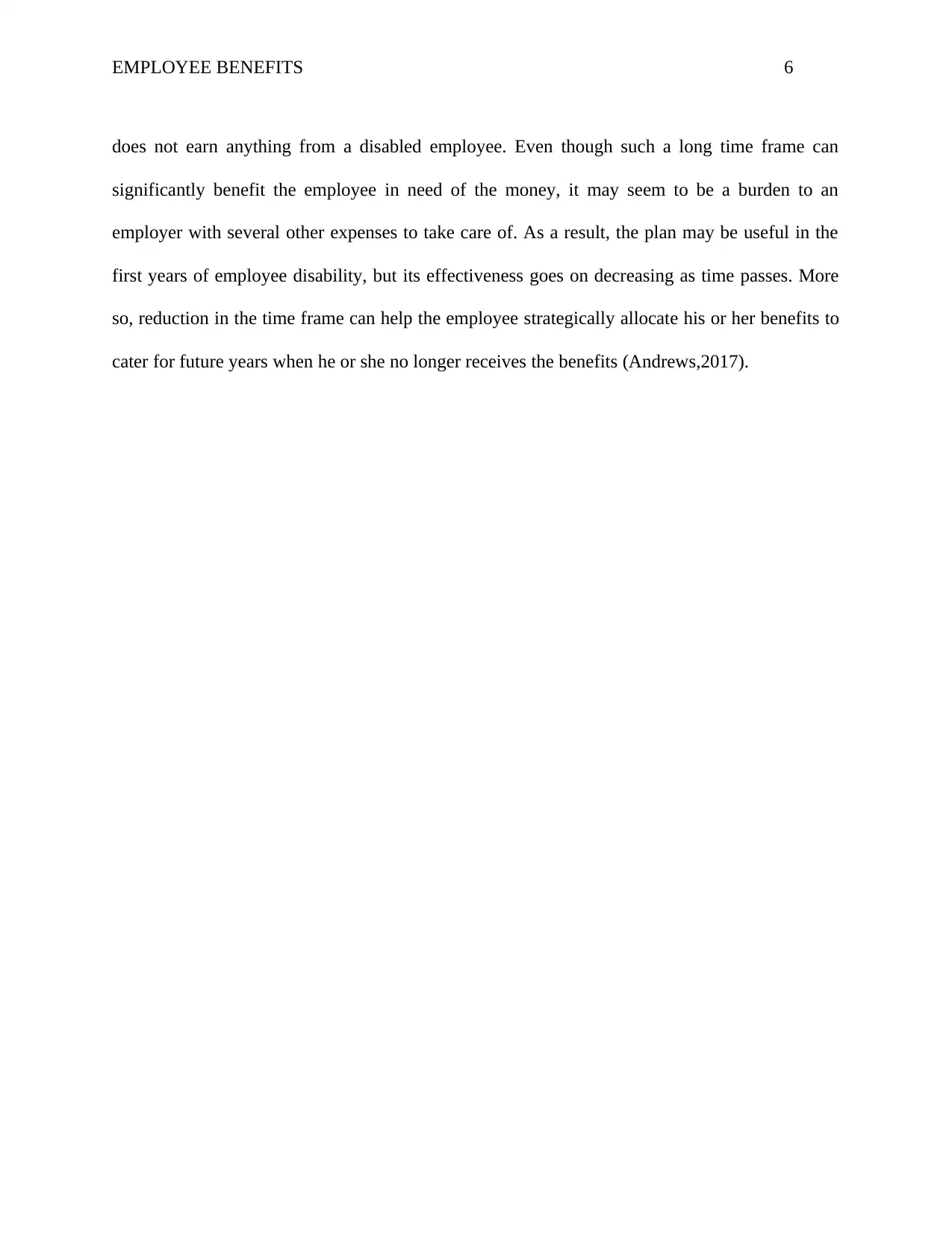
EMPLOYEE BENEFITS 6
does not earn anything from a disabled employee. Even though such a long time frame can
significantly benefit the employee in need of the money, it may seem to be a burden to an
employer with several other expenses to take care of. As a result, the plan may be useful in the
first years of employee disability, but its effectiveness goes on decreasing as time passes. More
so, reduction in the time frame can help the employee strategically allocate his or her benefits to
cater for future years when he or she no longer receives the benefits (Andrews,2017).
does not earn anything from a disabled employee. Even though such a long time frame can
significantly benefit the employee in need of the money, it may seem to be a burden to an
employer with several other expenses to take care of. As a result, the plan may be useful in the
first years of employee disability, but its effectiveness goes on decreasing as time passes. More
so, reduction in the time frame can help the employee strategically allocate his or her benefits to
cater for future years when he or she no longer receives the benefits (Andrews,2017).
⊘ This is a preview!⊘
Do you want full access?
Subscribe today to unlock all pages.

Trusted by 1+ million students worldwide
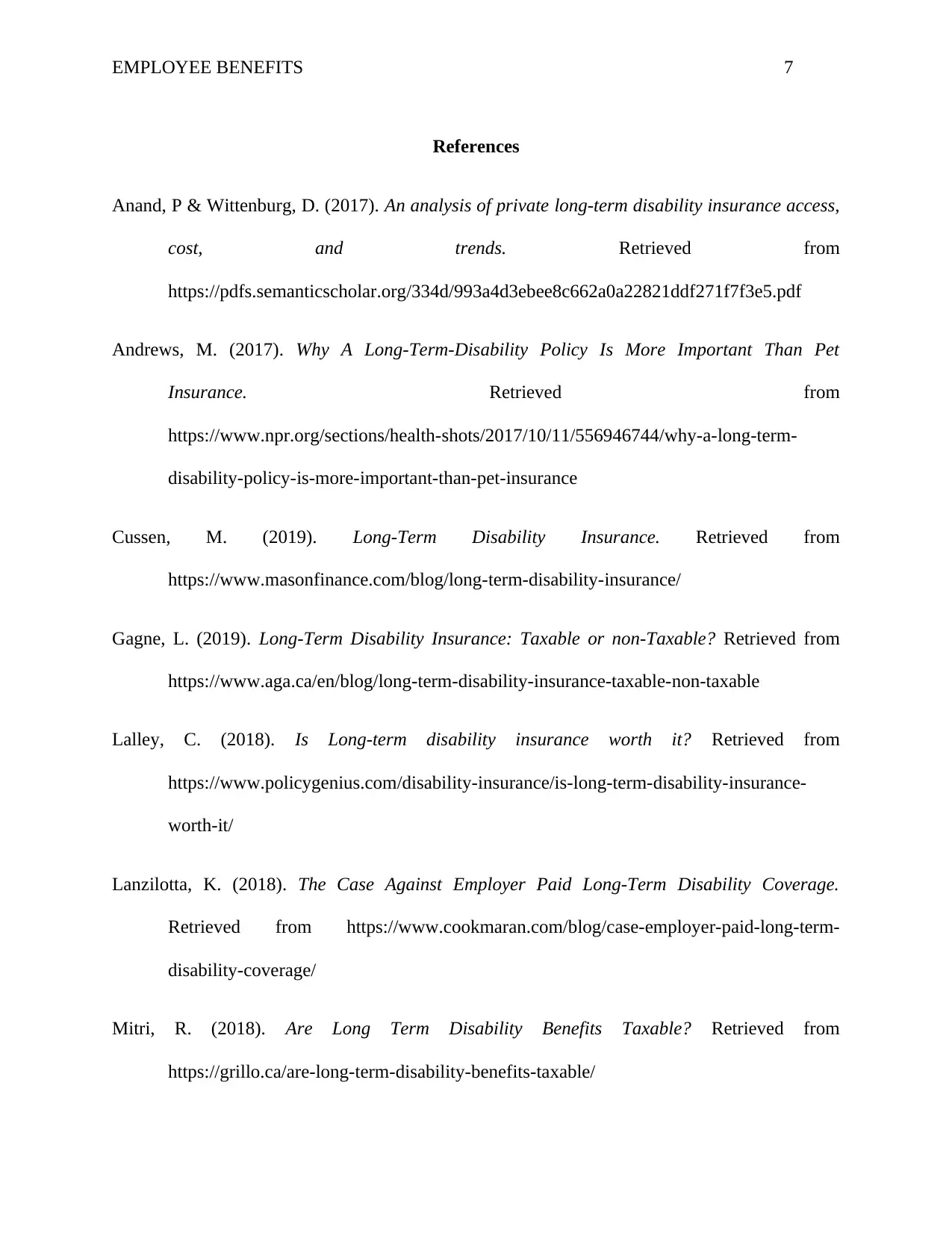
EMPLOYEE BENEFITS 7
References
Anand, P & Wittenburg, D. (2017). An analysis of private long-term disability insurance access,
cost, and trends. Retrieved from
https://pdfs.semanticscholar.org/334d/993a4d3ebee8c662a0a22821ddf271f7f3e5.pdf
Andrews, M. (2017). Why A Long-Term-Disability Policy Is More Important Than Pet
Insurance. Retrieved from
https://www.npr.org/sections/health-shots/2017/10/11/556946744/why-a-long-term-
disability-policy-is-more-important-than-pet-insurance
Cussen, M. (2019). Long-Term Disability Insurance. Retrieved from
https://www.masonfinance.com/blog/long-term-disability-insurance/
Gagne, L. (2019). Long-Term Disability Insurance: Taxable or non-Taxable? Retrieved from
https://www.aga.ca/en/blog/long-term-disability-insurance-taxable-non-taxable
Lalley, C. (2018). Is Long-term disability insurance worth it? Retrieved from
https://www.policygenius.com/disability-insurance/is-long-term-disability-insurance-
worth-it/
Lanzilotta, K. (2018). The Case Against Employer Paid Long-Term Disability Coverage.
Retrieved from https://www.cookmaran.com/blog/case-employer-paid-long-term-
disability-coverage/
Mitri, R. (2018). Are Long Term Disability Benefits Taxable? Retrieved from
https://grillo.ca/are-long-term-disability-benefits-taxable/
References
Anand, P & Wittenburg, D. (2017). An analysis of private long-term disability insurance access,
cost, and trends. Retrieved from
https://pdfs.semanticscholar.org/334d/993a4d3ebee8c662a0a22821ddf271f7f3e5.pdf
Andrews, M. (2017). Why A Long-Term-Disability Policy Is More Important Than Pet
Insurance. Retrieved from
https://www.npr.org/sections/health-shots/2017/10/11/556946744/why-a-long-term-
disability-policy-is-more-important-than-pet-insurance
Cussen, M. (2019). Long-Term Disability Insurance. Retrieved from
https://www.masonfinance.com/blog/long-term-disability-insurance/
Gagne, L. (2019). Long-Term Disability Insurance: Taxable or non-Taxable? Retrieved from
https://www.aga.ca/en/blog/long-term-disability-insurance-taxable-non-taxable
Lalley, C. (2018). Is Long-term disability insurance worth it? Retrieved from
https://www.policygenius.com/disability-insurance/is-long-term-disability-insurance-
worth-it/
Lanzilotta, K. (2018). The Case Against Employer Paid Long-Term Disability Coverage.
Retrieved from https://www.cookmaran.com/blog/case-employer-paid-long-term-
disability-coverage/
Mitri, R. (2018). Are Long Term Disability Benefits Taxable? Retrieved from
https://grillo.ca/are-long-term-disability-benefits-taxable/
Paraphrase This Document
Need a fresh take? Get an instant paraphrase of this document with our AI Paraphraser

EMPLOYEE BENEFITS 8
Sigel, Z. (2019). Are disability insurance benefits taxable? Retrieved from
https://www.policygenius.com/disability-insurance/are-disability-insurance-benefits-
taxable/
Sigel, Z. (2019). Are disability insurance benefits taxable? Retrieved from
https://www.policygenius.com/disability-insurance/are-disability-insurance-benefits-
taxable/
1 out of 8
Your All-in-One AI-Powered Toolkit for Academic Success.
+13062052269
info@desklib.com
Available 24*7 on WhatsApp / Email
![[object Object]](/_next/static/media/star-bottom.7253800d.svg)
Unlock your academic potential
Copyright © 2020–2025 A2Z Services. All Rights Reserved. Developed and managed by ZUCOL.
